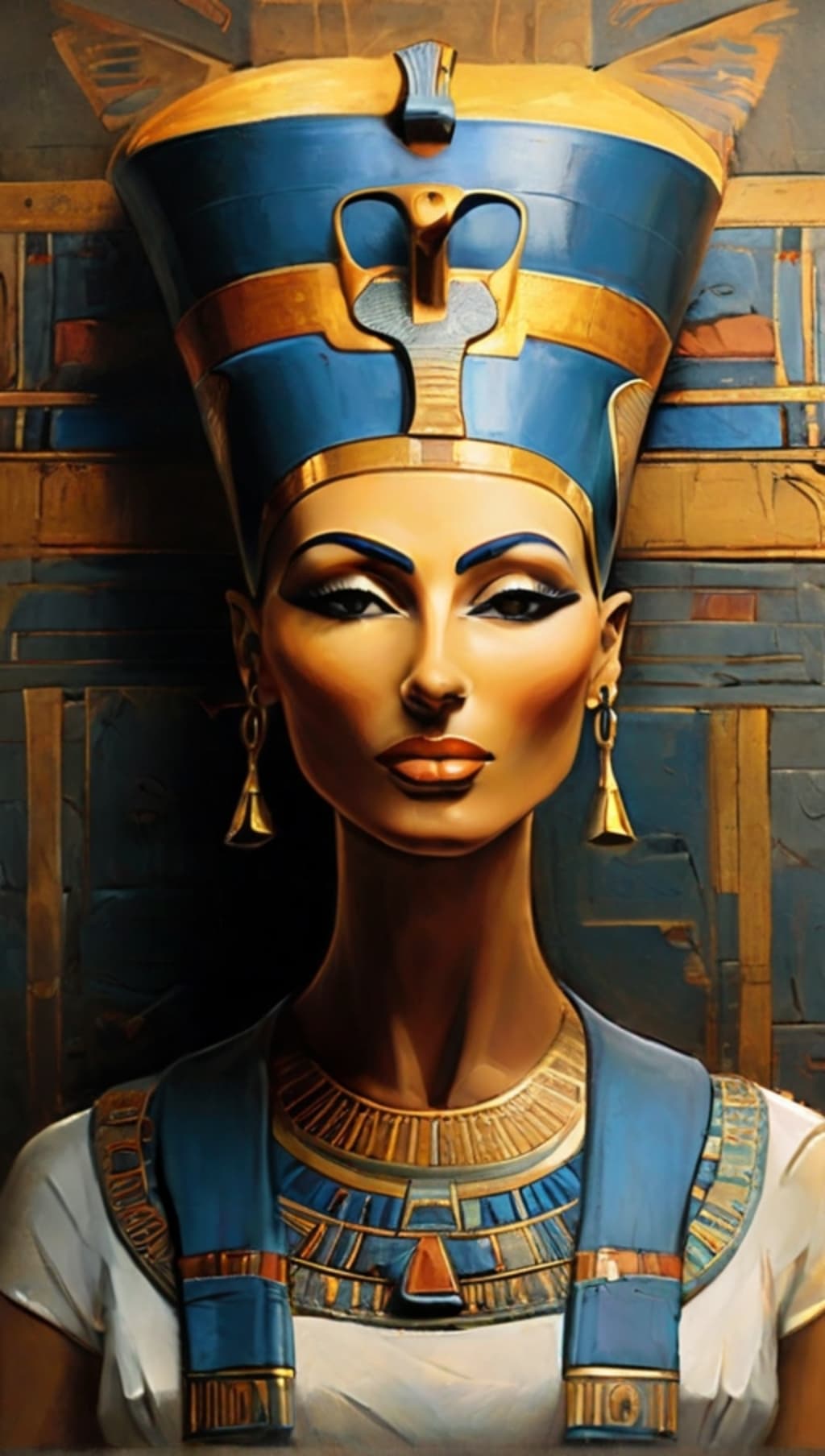"Nefertiti: Beauty, Power, and Mystery in Ancient Egypt's Amarna Period"
Queen Nefertiti, whose name means "a beautiful woman has come," remains one of ancient Egypt's most enigmatic and celebrated figures.

Queen Nefertiti, whose name means "a beautiful woman has come," remains one of ancient Egypt's most enigmatic and celebrated figures. Born around 1370 BCE, little is known about her early life, but her marriage to Pharaoh Akhenaten would propel her into the spotlight, making her a central figure in the Amarna Period.
Nefertiti's rise to prominence began when she married Amenhotep IV, who later changed his name to Akhenaten, during the early years of his reign. Akhenaten is famous for his radical religious reforms, primarily centered around the worship of the sun disc, Aten. This period marked a departure from traditional Egyptian polytheism and the construction of a new capital city, Akhetaten (modern-day Amarna).
As queen, Nefertiti played a crucial role in her husband's religious revolution. The couple presented themselves as living representatives of Aten, emphasizing their unique connection to the god. Nefertiti's depictions in art and sculpture during this period often portrayed her in intimate family scenes, showcasing her with Akhenaten and their daughters. The iconic bust of Nefertiti, discovered in 1912, is a masterpiece of ancient Egyptian art, capturing her renowned beauty.
Nefertiti's influence extended beyond the domestic sphere. She held considerable political power and, in some instances, may have acted as a co-regent alongside Akhenaten. The famous boundary stelae erected in Akhetaten depict Nefertiti engaging in religious ceremonies and receiving offerings, suggesting a level of authority not commonly granted to queens in ancient Egypt.
The Amarna Period was a time of profound change, both religiously and artistically. The artistic depictions of Nefertiti and the royal family shifted dramatically from traditional Egyptian art conventions. The representations were more naturalistic, capturing the human form with greater accuracy, and reflected the family's intimate moments.
Despite her prominence during Akhenaten's reign, Nefertiti's fate remains a subject of debate among historians and archaeologists. Some theories suggest that she outlived Akhenaten and may have ruled briefly as pharaoh in her own right, possibly under the name Neferneferuaten. Others propose that she died during Akhenaten's reign, and her daughter Meritaten may have taken on a more prominent role.
The subsequent reign of Tutankhamun, believed by some to be Nefertiti's son, marked a return to traditional Egyptian religious practices and the abandonment of Akhetaten. The name of Nefertiti largely disappears from historical records after this period.
The mystery surrounding Nefertiti's later years and her ultimate fate adds to the allure of her legacy. Whether she continued to influence the course of Egyptian history or retreated into obscurity, Queen Nefertiti's impact on the Amarna Period and ancient Egyptian art and culture is undeniable. Her beauty, intelligence, and role in a time of religious upheaval continue to captivate historians, archaeologists, and enthusiasts alike, making her a legendary figure in the annals of ancient Egypt.
"Nefertiti: Beauty, Power, and Mystery in Ancient Egypt's Amarna Period"
Queen Nefertiti, the captivating figure whose name echoes through the corridors of ancient history, rose to prominence around 1370 BCE in the vibrant tapestry of ancient Egypt. Born into obscurity, she would soon become an icon of beauty, power, and mystery, leaving an indelible mark on the Amarna Period.
Nefertiti's journey into prominence commenced with her union to Amenhotep IV, later known as Akhenaten, during the early years of his reign. Their matrimonial bond would not only shape her destiny but also redefine the religious and political landscape of Egypt. Akhenaten's radical religious reforms, centered on the worship of the sun disc, Aten, marked the beginning of the Amarna Period, and Nefertiti stood by his side as a central figure in this transformative era.
Nefertiti's influence extended beyond the traditional roles of a queen. Actively participating in Akhenaten's religious revolution, she portrayed herself as a living representative of Aten. Intimate family scenes depicted in art and sculpture showcased her alongside Akhenaten and their daughters, providing a glimpse into the royal household's dynamics. The renowned bust of Nefertiti, an exquisite artifact of ancient Egyptian art, immortalizes her unparalleled beauty and grace.
Her political influence was equally significant, challenging the conventions of her time. In the boundary stelae of Akhetaten, Nefertiti engaged in religious ceremonies and received offerings, suggesting a level of authority rarely afforded to queens in ancient Egypt. Her role as a potential co-regent underscores the depth of her impact on the political stage.
The Amarna Period witnessed not only religious revolution but also artistic innovation. Representations of Nefertiti and the royal family departed from traditional norms, embracing naturalistic portrayals that captured the humanity of the subjects. These artistic shifts mirrored the broader changes occurring in Egypt during this period.
Yet, despite her prominence, Nefertiti's later years remain shrouded in mystery. Theories abound regarding her fate, with some suggesting that she outlived Akhenaten and may have ruled independently. The possible reign of a pharaoh named Neferneferuaten adds complexity to the narrative. Others propose that she met her demise during Akhenaten's rule, leaving her daughter Meritaten to assume a more prominent role.
With the subsequent reign of Tutankhamun, thought by some to be Nefertiti's son, Egypt returned to its traditional religious practices, and the city of Akhetaten was abandoned. Nefertiti's name fades from historical records, leaving a void that fuels speculation about her ultimate fate.
The allure of Nefertiti's legacy lies not only in her undeniable beauty but in the enigmatic nature of her life and death. Whether she continued to shape Egypt's destiny or retreated into historical obscurity, Nefertiti remains an enduring symbol of a remarkable era. Her beauty, intelligence, and role in a time of religious and artistic upheaval continue to captivate scholars and enthusiasts alike, making her an immortal figure in the annals of ancient Egypt.
About the Creator
Nada soliman
You will read about the facts of countries, animals, and many things in our lives. You will listen a lot. Visit us now






Comments
There are no comments for this story
Be the first to respond and start the conversation.